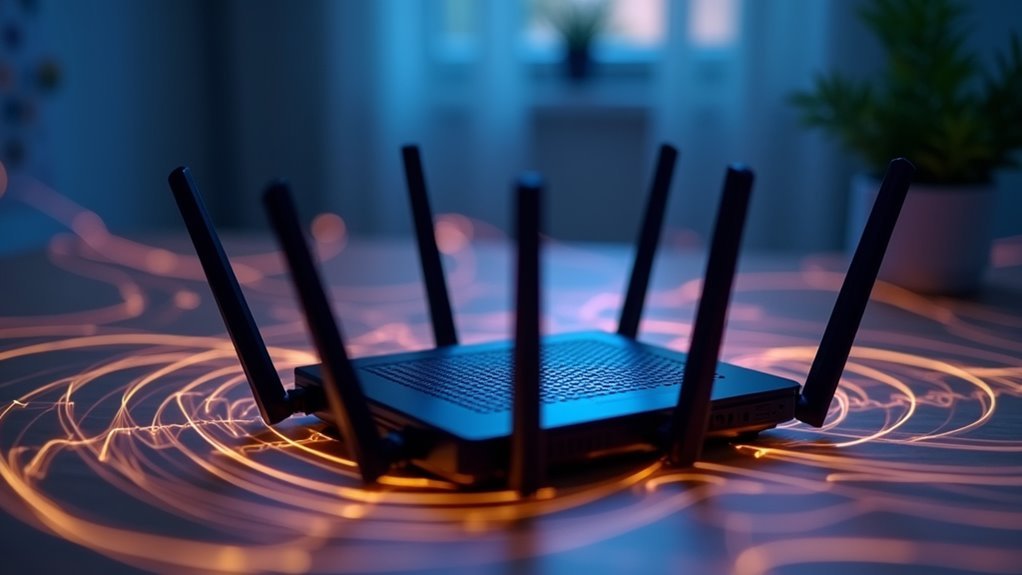You’re probably frustrated with your mesh WiFi system’s inconsistent speeds and dead zones, despite investing in what seemed like a premium solution. The truth is, most users never properly optimize their mesh networks, leaving significant bandwidth untapped. Your current setup likely suffers from poor node placement, wireless interference, and inefficient traffic management. These seven proven techniques will transform your sluggish network into a high-performance system that actually delivers on its promises.
Strategic Node Placement for Maximum Coverage and Signal Strength

When optimizing your mesh WiFi network, strategic node placement serves as the foundation for achieving maximum coverage and eliminating frustrating dead zones.
Position your main router centrally in your home to maximize signal distribution across all areas. Maintain no more than two rooms’ distance between mesh nodes, targeting at least -60 dBm signal strength between each unit.
Avoid placing nodes near thick walls or large furniture that create obstructions and weaken your Wi-Fi signal. Use companion apps to monitor real-time performance and experiment with different configurations.
For multi-story homes, strategically position nodes on different floors to guarantee extensive coverage throughout your entire space, optimizing both horizontal and vertical signal propagation.
Wired Backhaul Implementation to Reduce Wireless Congestion
You’ll dramatically improve your mesh network’s performance by implementing wired backhaul connections between nodes using Ethernet cables.
This setup eliminates the wireless interference that typically degrades signal quality and creates bottlenecks in your network traffic.
The performance gains you’ll experience include dedicated bandwidth allocation, reduced congestion, and markedly faster data transmission speeds throughout your entire mesh system.
Ethernet Cable Setup Benefits
While wireless backhaul connections can create bottlenecks that reduce your mesh network’s overall performance, implementing wired Ethernet backhaul transforms your system into a high-speed powerhouse that delivers maximum bandwidth to every connected device.
| Connection Type | Bandwidth Utilization |
|---|---|
| Wireless Backhaul | Up to 50% available |
| Ethernet Cable | 100% available |
| Wireless Interference | Signal degradation |
| Wired Setup | Zero interference |
You’ll experience dramatically improved network responsiveness with low latency connections that support multiple devices simultaneously. Ethernet cable setup eliminates the wireless spectrum congestion that typically hampers performance, ensuring stable connections across your entire network. Your gaming sessions become smoother, video streaming buffers less frequently, and smart home devices respond instantly to commands.
Reducing Wireless Interference Issues
Wired backhaul implementation directly addresses one of mesh networking’s most persistent challenges: wireless spectrum congestion that throttles your network’s potential.
By establishing dedicated Ethernet connections between mesh nodes, you’re eliminating the wireless interference that occurs when your network competes for the same radio frequencies.
This strategic approach delivers measurable performance improvements:
- Dedicated client bandwidth – Your devices get exclusive access to wireless channels without backhaul traffic interference
- Reduced signal degradation – Fewer wireless hops mean stronger, more stable connections throughout your network
- Enhanced reliability – Wired connections resist physical obstructions and electromagnetic interference that plague wireless backhaul
- Optimized spectrum utilization – Mesh nodes focus their wireless capacity entirely on serving your devices rather than inter-node communication
Your network’s stability increases dramatically when backhaul traffic moves off congested wireless channels.
Performance Gains Analysis
Once you implement wired backhaul connections, the performance improvements become immediately apparent through measurable bandwidth and latency metrics.
Your mesh system delivers best performance and reliability when nodes are wired for Ethernet, creating dedicated pathways that eliminate wireless communication bottlenecks between units. You’ll achieve bandwidth utilization improvements up to 100%, as your wireless channels focus exclusively on serving client devices rather than managing inter-node traffic.
These gains prove especially valuable in multi-story homes where physical obstructions like thick walls and floors create challenges.
Quality of Service (QoS) Configuration for Priority Traffic Management
Although your mesh WiFi system distributes internet access across multiple nodes, it can’t automatically distinguish between your teenager’s TikTok scrolling and your critical work video call.
That’s where Quality of Service (QoS) configuration becomes vital for managing priority traffic and optimizing your network’s performance.
QoS allows you to prioritize traffic for high-demand applications like video streaming and smart home devices. You’ll reduce latency and improve user experience by minimizing buffering during peak usage times.
Configure QoS through your mesh system’s app by setting:
- Device-specific bandwidth limits for smartphones and smart TVs
- Application priorities for video conferencing and gaming
- Traffic management rules for different network usage patterns
- Automatic adjustments for changing household demands
Regular monitoring guarantees your QoS settings remain effective as your network usage patterns evolve.
RF Environment Optimization Using 5GHz and DFS Channels

While QoS manages traffic priorities effectively, your mesh network’s performance ultimately depends on selecting the best radio frequencies to minimize interference and maximize throughput.
The 5 GHz band delivers superior performance compared to congested 2.4 GHz frequencies, making it essential for bandwidth enhancement in modern mesh systems.
The 5 GHz band outperforms congested 2.4 GHz frequencies, making it crucial for optimizing bandwidth in modern mesh networks.
You’ll gain significant advantages by enabling DFS channels on your mesh nodes. These additional frequencies provide up to 24 non-overlapping channels, dramatically reducing interference from neighboring networks.
Your mesh systems should automatically monitor the RF environment and switch to less crowded DFS channels when congestion occurs.
Ensure your mesh hardware supports both standard 5 GHz and DFS channels. This capability maximizes network performance by accessing the full spectrum of available frequencies, delivering ideal throughput across your entire coverage area.
Wireless Hop Limitation to Maintain Network Throughput
You’ll need to implement a strict two-hop maximum rule in your mesh network to prevent severe bandwidth degradation that occurs with each additional wireless hop.
Strategic placement of your mesh nodes becomes critical since positioning them too far from wired connections or the primary router forces traffic through multiple hops unnecessarily.
Your goal is optimizing node placement to create the shortest wireless paths while maintaining strong signal strength between connected access points.
Two-Hop Maximum Rule
Performance degradation becomes inevitable when mesh networks exceed two wireless hops between devices and their wired connection point. The two-hop maximum rule exists because each additional wireless hop effectively halves your available bandwidth, creating bottlenecks that slow your entire mesh network.
To optimize your wireless hops and maintain peak performance:
- Position Access Points closer to wired connections or each other
- Monitor signal strength between mesh nodes, maintaining -60 dBm minimum
- Distribute APs evenly throughout your coverage area
- Avoid connecting multiple child nodes to a single parent AP
You’ll notice significant performance degradation when devices must traverse more than two hops to reach their destination.
Strategic AP placement guarantees your mesh network delivers consistent speeds across your entire coverage area.
Placement Strategy Optimization
Strategic placement of your mesh access points directly impacts network throughput by controlling the wireless hop count between devices and their wired connection sources.
Your placement strategy enhancement should prioritize positioning meshed APs as close as possible to wired connections, maintaining signal strength of at least -60 dBm between units. This approach guarantees peak network throughput while minimizing bandwidth degradation.
You’ll reduce interference by distributing load evenly across multiple parent APs rather than overloading single units.
Position your mesh Wi-Fi systems strategically to eliminate dead zones while preventing excessive wireless hops that compromise connectivity.
Regular monitoring allows you to adjust AP placement when signal strength weakens, guaranteeing consistent performance throughout your network coverage area.
Parent AP Load Balancing to Prevent Single Point Bottlenecks

When multiple devices compete for bandwidth through a single access point, your entire mesh network suffers from performance degradation that ripples across all connected clients.
Effective parent AP load balancing prevents single AP bottleneck scenarios that devastate network performance and compromise bandwidth distribution.
Strategic mesh topology planning guarantees ideal bandwidth availability across your network:
- Deploy multiple parent APs throughout your coverage area to distribute wireless backhaul load evenly
- Limit hop counts to maximum two between client devices and nearest parent AP for reduced latency
- Monitor AP loads continuously to identify overloaded units before performance degrades
- Implement designated uplinks with balanced placements for congestion prevention
You’ll achieve superior network performance when wireless backhaul load distributes efficiently across multiple access points rather than overwhelming single connection points.
Regular Network Monitoring and Device Traffic Analysis
Although your mesh network may appear to function smoothly on the surface, hidden bottlenecks and bandwidth-hungry devices can silently degrade performance across your entire system.
Regular network monitoring using specialized tools helps you identify areas of weak signal strength and pinpoint which devices consume excessive bandwidth.
Device traffic analysis enables effective bandwidth management by revealing usage patterns and highlighting unauthorized access attempts.
You’ll discover outdated devices impacting network performance and can schedule heavy downloads during off-peak hours.
These monitoring tools also detect environmental factors affecting your network, such as new physical obstructions or neighboring network interference.
Frequently Asked Questions
How Can I Improve My Mesh Wifi Speed?
You’ll boost mesh WiFi speed by using wired backhaul connections between nodes, limiting wireless hops to two maximum, positioning nodes for -60 dBm signal strength, and utilizing 5 GHz bands whenever possible.
What Is the Best Layout for Mesh Wifi?
Place your main router centrally in your home. Position mesh nodes within two rooms of each other, keeping them elevated and in open spaces. Avoid dead zones directly—place nodes adjacent to improve coverage instead.
What Is a Major Disadvantage of a Mesh Network?
You’ll face significant bandwidth reduction as your mesh network’s backhaul connection shares bandwidth with connected devices. When multiple devices stream simultaneously, they’ll compete for the same limited bandwidth, slowing everyone’s speeds considerably.
How Do I Boost My Wifi Mesh?
You’ll boost your mesh network by positioning access points within -60 dBm signal range, using wired backhaul connections, limiting wireless hops to two maximum, selecting uncrowded channels, and updating firmware regularly.





Leave a Reply